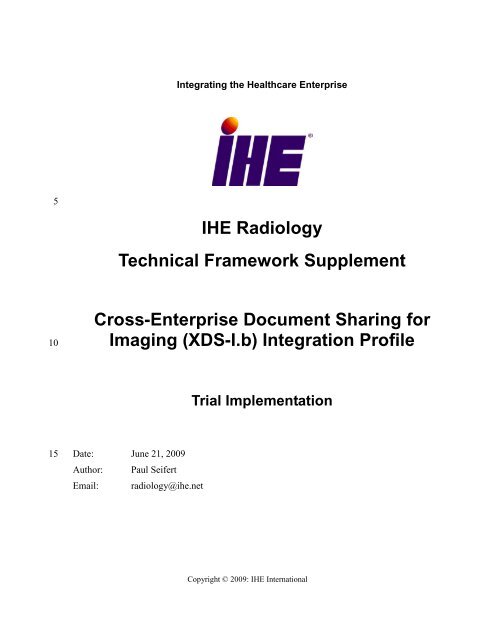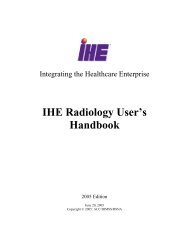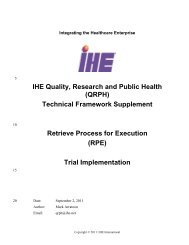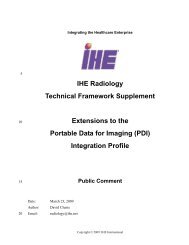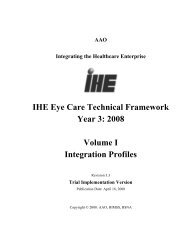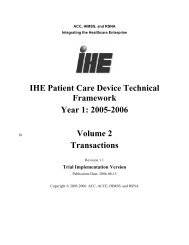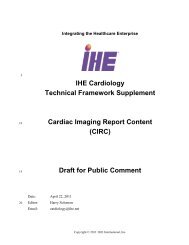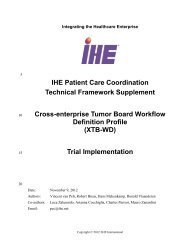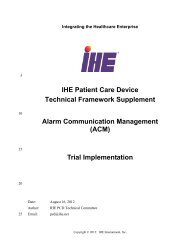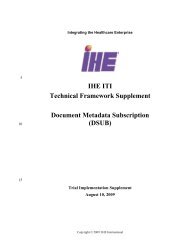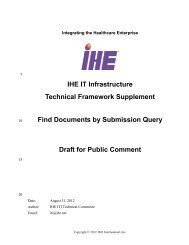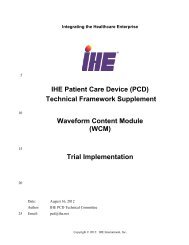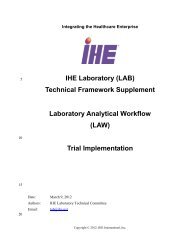XDS - IHE
XDS - IHE
XDS - IHE
Create successful ePaper yourself
Turn your PDF publications into a flip-book with our unique Google optimized e-Paper software.
Integrating the Healthcare Enterprise5<strong>IHE</strong> RadiologyTechnical Framework Supplement10Cross-Enterprise Document Sharing forImaging (<strong>XDS</strong>-I.b) Integration ProfileTrial Implementation15Date: June 21, 2009Author: Paul SeifertEmail: radiology@ihe.netCopyright © 2009: <strong>IHE</strong> International
<strong>IHE</strong> Radiology Technical Framework Supplement - <strong>XDS</strong>-I.b______________________________________________________________________________Open Issues and Questions# Issue/ (Answer)18 How long should Document Consumers wait for “Retrieve Imaging Document Set”response?The newly added, web services-based “Retrieve Imaging Document Set” Transaction(RAD-69) is a synchronous transaction whose response is expected to carry a significantsized payload (e.g., 10‟s or 100‟s of MB). In addition, the images being retrieved maynot be immediately available from the Imaging Document Source (e.g., they may be innearline or offline storage). It may be necessary to mitigate these issues in the future, byallowing the Imaging Document Consumer to specify what availability level (ONLINE,NEARLINE or OFFLINE) it is willing to wait for and/or adapting the <strong>XDS</strong>.b AsyncOption to <strong>XDS</strong>-I.b.Feedback from Trial Implementers on the degree to which this is a problem along withalternatives for mitigation is encouraged.Closed Issues# Issue/ (Answer)1 Need to reach consensus on which approach to take based on the pros and cons of eachapproach (see “Alternative Approaches” section below). The Use Case section of theoriginal Detailed Profile Proposal makes the case for focusing efforts on a singletechnology and the resulting simplification. Can we commit to removing <strong>XDS</strong>.a from<strong>XDS</strong>-I and adding <strong>XDS</strong>.b to achieve this?Answer: Consensus of the Technical Committee was to keep a single version of the <strong>XDS</strong>-Iprofile and replace the <strong>XDS</strong>.a transport mechanisms with <strong>XDS</strong>.b mechanisms.3 The workitem is currently using the “Supplement” format. Is there a compelling reasonto change this?Answer: No compelling reason to change the current draft. The Supplement format willbe used4 Is the scope of the work item limited to pairing <strong>XDS</strong>-I with <strong>XDS</strong>.b, or will it also addressXCA, XDR, XDM, etc.?Answer: The current proposal indeed limits the scope to pairing <strong>XDS</strong>-I with the <strong>XDS</strong>.btransport mechanisms. The current choice of approach may not require any specialspecification to enable XCA capabilities for imaging.__________________________________________________________________________Rev. 1.1 - 2009-06-214Copyright © 2009: <strong>IHE</strong> International
<strong>IHE</strong> Radiology Technical Framework Supplement - <strong>XDS</strong>-I.b______________________________________________________________________________# Issue/ (Answer)7 At some point there will likely be a need/desire to address Web services-based transferprotocols for images in coordination with DICOM WG10 and ITI. Are there benefits ofupgrading <strong>XDS</strong>-I to use current <strong>XDS</strong>.b transport mechanisms without replacing theDICOM object retrievals with their to-be-developed web services counterparts?Answer: T he current version of the supplement includes an approach for a web servicesbased DICOM image retrieval. This new transaction is required to be supportedby the Imaging Document Source Actor.8 Are the added profile dependency on ATNA/ Radiology Option and the correspondingupdate made to RAD TF-1: 18.6 adequate specifications for the security requirements(beyond what is already listed in and RAD TF-1: Appendix H)?Answer: The current specification is believed to be adequate9 What is the most effective way to reference ITI‟s <strong>XDS</strong> (<strong>XDS</strong>.a/ <strong>XDS</strong>.b) profiles,especially considering that <strong>XDS</strong>.b has not yet been folded in the ITI TF (e.g., §4.54.4.1)?Answer: The current Final Text ITI TF makes appropriate references to the <strong>XDS</strong>.b TISupplement, thus referring to <strong>XDS</strong> (or <strong>XDS</strong>.b) via the main ITI TF and its correspondingsections is appropriate and adequate.10 Should the „Referenced Standards‟ section of the Provide and Register ImagingDocument Set transaction (4.54.3) include actual references, or instead just refer to ITITF-2:3.41.3 - the References section for the ITI-41 transaction. That way if ITI makeschanges, the RAD transaction just inherits them.Answer: A reference is made to the <strong>XDS</strong>.b Referenced Standards section and only theradiology-specific standards are explicitly listed.11 The Provide and Register Imaging Document Set transaction (RAD-54) includes copiesof the metadata tables included in the ITI Framework with updates / overrides to a subsetof the attributes (mostly in the source/ value of the attribute). In some cases, it is theDocument Repository‟s responsibility to fill/ populate the attribute, but the DocumentRepository is not strictly part of the <strong>XDS</strong>-I profile. In addition, the expected actionsdescribe some required behaviors of the Document Repository. Is there a better way todocument this information without losing too much contextual information?Answer: The RAD-54 transaction is being retired and replaced by a new RAD-68transaction based on <strong>XDS</strong>.b’s Provide and Register Document Set-b. The new RAD-68transaction is written to specify only “delta requirements” and makes liberal use ofreferences to the baseline ITI transaction. The new transaction (RAD-68) is named:“Provide and Register Imaging Document Set – b”.__________________________________________________________________________Rev. 1.1 - 2009-06-215Copyright © 2009: <strong>IHE</strong> International
<strong>IHE</strong> Radiology Technical Framework Supplement - <strong>XDS</strong>-I.b______________________________________________________________________________# Issue/ (Answer)12 This supplement retires <strong>XDS</strong>-I (on <strong>XDS</strong>.a) and replaces it by a functionally equivalentprofile using <strong>XDS</strong>.b transport mechanisms. The replacement profile has been given adifferent name: XIDS. Is this OK? Or should we reuse the <strong>XDS</strong>-I name for <strong>XDS</strong>-I.b? Therationale for renaming the profile rather than to simply change the underlying transport isto minimize confusion. Does renaming the profile really accomplish this? Should theprofile name be more “drastically” different?Answer: The new profile name remains the same, but the abbreviation is changed to be:<strong>XDS</strong>-I.b13 The Radiology Technical Committee believes it would be useful to write a CP to the ITITF to include a (backward) pointer from the ITI-42 (Provide and Register Document Set)transaction to the new RAD-68 transaction (the new Provide and Register ImagingDocument Set) as a reminder that there is a dependant transaction.Answer: Tentative agreement was reached in a joint RAD, ITI call to give futureconsideration to refactoring of the RAD Technical Frameworks to distinguish contentprofiles and integration profiles. Given this, no CP will be written..14 The current version of the <strong>XDS</strong>-I.b supplement adds a new transaction that is web serviceequivalent of the DICOM retrieve transactions between the Imaging DocumentConsumer and Imaging Document Source. Is this acceptable or should this supplementwait until next year‟s cycle when it is expected that DICOM WG-27 is expected to havecompleted specifying an “official” DICOM mechanism to do this?Answer: This is the approach that will be taken this cycle. Subject to prototyping andtesting, etc. <strong>IHE</strong> may need to go back to WG-27 to ask for their assistance. The initialpublication of this supplement is not dependent on the timing of this activity.15 Retrieval of a display-ready image (via WADO) cannot be secured in the same fashion asthe image retrieval via web services (as introduced in this supplement). It will requirework in DICOM WG-27 to create a web services equivalent to the current WADO.Answer: This request was made to WG-27 during a recent joint <strong>IHE</strong>/ WG-27 tcon. It wasagreed to have members of the Radiology and ITI Technical Committees and WG-27participate in a risk analysis activity to confirm the need for user authentication for theWADO transaction. If needed, a mechanism will need to be agreed to and then developedby WG-27. The publication of this supplement is not dependent on the timing of this jointactivity.16 The Radiology Technical Committee has submitted a DICOM CP requesting the additionof a “Retrieve Location UID” to be used in both the Provide & Register Imaging__________________________________________________________________________Rev. 1.1 - 2009-06-216Copyright © 2009: <strong>IHE</strong> International
<strong>IHE</strong> Radiology Technical Framework Supplement - <strong>XDS</strong>-I.b______________________________________________________________________________# Issue/ (Answer)Document Set transaction and the Retrieve Imaging Document Set transaction. Thesupplement is written assuming this CP will be accepted. If not the text will have to bereworked slightly to reflect using only Retrieve AE Title instead of the proposed“Retrieve Location UID” attribute.Answer: DICOM CP 958 was accepted and is being worked on by DICOM.17 The supplement specifies implicit little-endian as the only pixel data encoding allowed tobe used for DICOM images sent in the response to a Retrieve Document Set Transaction.The Technical Committee is soliciting feedback on this approach.Answer: An optional transfer syntax list element/ attribute will be added to retrievedocument set <strong>XDS</strong> schema and will be specialized (i.e., required) by the Radiologytransaction.__________________________________________________________________________Rev. 1.1 - 2009-06-217Copyright © 2009: <strong>IHE</strong> International
<strong>IHE</strong> Radiology Technical Framework Supplement - <strong>XDS</strong>-I.b______________________________________________________________________________165evidence documents, and presentation states), diagnostic imaging reports provided in aready-for-display format.Since the <strong>XDS</strong>-I.b Profile depends on and extends the IT Infrastructure <strong>XDS</strong>.b Profileincluding the use of terms defined in <strong>XDS</strong> (e.g., <strong>XDS</strong> Affinity Domain, submission set, etc.)the reader of <strong>XDS</strong>-I.b is expected to have read and understood the <strong>XDS</strong> Profile.170175180185Make the following changes to the transaction descriptions in section 2.4 (adding the new transactiondescriptions at the end of the list in the section).54. Provide and Register Imaging Document Set [DEPRECATED] - This transactionhas been deprecated and is superseded by the Provide and Register ImagingDocument Set – MTOM/XOP Transaction (RAD TF-3: 4.68) as part of the Cross-Enterprise Document Sharing for Imaging (<strong>XDS</strong>-I.b) Profile. Imaging DocumentSource actor initiates the Provide and Register Imaging Document Set transaction.For each document in the Submission Set, the Imaging Document Source actorprovides both the documents as an opaque octet stream and the correspondingmeta-data to the Document Repository. The Document Repository is responsibleto persistently store these documents, and to register them in the DocumentRegistry using the Register Documents transaction by forwarding the documentmeta-data received from the Imaging Document Source Actor. [RAD-54, derivedfrom ITI-15].55. …68. Provide and Register Imaging Document Set–MTOM/XOP – An ImagingDocument Source Actor uses the Provide and Register Imaging Document SetTransaction to submit documents with associated metadata to a DocumentRepository. [RAD-68 specializes ITI-41].19069. Retrieve Imaging Document Set – An Imaging Document Consumer Actor usesthis Transaction to issue a web service request to retrieve a set of DICOMinstances. [RAD-69 specializes ITI-43].__________________________________________________________________________Rev. 1.1 - 2009-06-2110Copyright © 2009: <strong>IHE</strong> International
<strong>IHE</strong> Radiology Technical Framework Supplement - <strong>XDS</strong>-I.b______________________________________________________________________________Make the following changes to the Integration Profiles Transaction table (2.4-1) in section 2.4Integration ProfileTransaction…Provide and RegisterImaging Document Set[RAD-54]…Provide and RegisterImaging Document Set –MTOM/XOP [RAD-68]Retrieve Imaging DocumentSet [RAD-69]SWF PIR PWF RWF CHG CPI PGP KIN ED NM SINR PDI ARI <strong>XDS</strong>-I.b MAMMO IRWF TCEXXX195__________________________________________________________________________Rev. 1.1 - 2009-06-2111Copyright © 2009: <strong>IHE</strong> International
<strong>IHE</strong> Radiology Technical Framework Supplement - <strong>XDS</strong>-I.b______________________________________________________________________________Modify RAD TF-1:18 as follows18 Cross-eEnterprise Document Sharing for Imaging (<strong>XDS</strong>-I.b)Integration Profile200205210215220225230IMPORTANT: The Cross-Enterprise Document Sharing for Imaging (<strong>XDS</strong>-I) IntegrationProfile (originally found here) has been deprecated and is replaced by a functionallyequivalent profile called Cross-Enterprise Document Sharing for Imaging (<strong>XDS</strong>-I.b), whichis described in the remainder of this section.The Cross-Enterprise Document Sharing (<strong>XDS</strong>) Profiles in the <strong>IHE</strong> IT Infrastructure Domainprovides a solution for sharing (publishing, finding and retrieving) documents across a group ofaffiliated enterprises. The <strong>XDS</strong> for Imaging (<strong>XDS</strong>-I.b) Profile, defined here, extends andspecializes the mechanisms defined by <strong>XDS</strong>.b to support imaging “documents”, specificallyincluding the following:Imaging studies that include images acquired on a broad range of different modalities,as well as evidence documents (e.g. post-processing measurements/analysisoutcome), and presentation states.Diagnostic reports resulting from the interpretation of one or more related imagingstudies provided in a ready-for-display formA selection of diagnostically significant images associated with the report content.These document types along with the actor capabilities required to share them are defined by thisprofile.Since the <strong>XDS</strong> for Imaging (<strong>XDS</strong>-I.b) Profile depends on and extends the IT Infrastructure<strong>XDS</strong>.b Profile including the use of terms defined in <strong>XDS</strong> (e.g., <strong>XDS</strong> aAffinity dDomain,submission set, etc.) the reader of <strong>XDS</strong>-I.b is expected to have read and understandsunderstood the <strong>XDS</strong> Profiles (See ITI TF-1: 10). The <strong>XDS</strong>-I.b specification does not repeatrequirements and text for the <strong>XDS</strong>-defined Actors Document Repository, Document Registry,and Document Consumer, and does not place any new requirements on these actors.Both the <strong>XDS</strong>.b and <strong>XDS</strong> for Imaging (<strong>XDS</strong>-I.b) Profiles are not intended to address all crossenterpriseEHR communication needs. Many scenarios may require the use of other <strong>IHE</strong>Integration profiles, such as Patient Identifier Cross-Referencing (PIX), Audit Trail and NodeAuthentication (ATNA), Enterprise User Authentication (EUA), Cross-eEnterprise UserAuthentication (XUA) and Retrieve Information for Display (RID). Other scenarios may be onlypartially supported, while still others may require future <strong>IHE</strong> Integration profiles, which will bedefined by <strong>IHE</strong> as soon as the necessary base standards are available. Specifically:1. The operation of any <strong>XDS</strong>-I Clinical <strong>XDS</strong> Affinity Domain will require that a propersecurity model be put in place. It is expected that a range of security models should be__________________________________________________________________________Rev. 1.1 - 2009-06-2112Copyright © 2009: <strong>IHE</strong> International
<strong>IHE</strong> Radiology Technical Framework Supplement - <strong>XDS</strong>-I.b______________________________________________________________________________235240245250255260possible. Although the <strong>XDS</strong>-I.b Integration Profile is not intended to include norrequire any specific security model, it is required expected that <strong>XDS</strong>-I.b implementersshall will group <strong>XDS</strong>-I.b Actors with actors from the <strong>IHE</strong> Audit Trail and NodeAuthentication and will need an Access Control capability that operates in such a crossenterpriseenvironment. New <strong>IHE</strong> Integration Profiles have been identified ascandidates (e.g. Public Key Infrastructure, Access Control, etc.). There is a discussionof <strong>XDS</strong>-I.b security considerations in RAD TF-1: Appendix H.2. The establishment of independent but consistently <strong>XDS</strong>-based Affinity Domainswill call for their federation, as patients expect their records to follow them as theymove from region to region, or country to country. <strong>IHE</strong> foresees a need fortransferring information from one Clinical Affinity Domain to another, or to allowaccess from one Affinity Domain to documents managed in other AffinityDomains. <strong>XDS</strong>/ <strong>XDS</strong>-I has been designed with this extension in mind. An <strong>XDS</strong>/<strong>XDS</strong>-I Domains Federation Integration Profile that complements <strong>XDS</strong> may beanticipated in the future.3. <strong>XDS</strong> and <strong>XDS</strong>-I.b do not address transactions for the management or configuration ofan clinical <strong>XDS</strong> aAffinity dDomain. For example, the configuration of networkaddresses or the definition of what type of clinical information is to be shared isspecifically left up to the policies established by the clinical <strong>XDS</strong> aAffinity dDomain.4. <strong>XDS</strong> and <strong>XDS</strong>-I.b do not specifically address the patient information reconciliationprocess necessary between the Clinical <strong>XDS</strong> Affinity Domain and any other localpatient identity domains that Document Sources and Document Consumers may bemembers of. For a discussion of some of these issues see RAD TF-1: Appendix G.5. <strong>XDS</strong> and <strong>XDS</strong>-I.b do not directly address the rendering and display of thedocuments retrieved by the Document and Imaging Document Consumers. Userswishing to achieve a well defined level of display/ rendering capability simply needto request systems that combine the <strong>XDS</strong>-I.b Imaging Document Consumer Actorwith an Image Display Actor from the appropriate Profile (e.g., MammographyImage, NM Image, Basic Image Review, etc).Update RAD TF-1:18.1 as described below, including replacement of Figure 18.1-1 with the diagramshown below18.1 Actors/ Transactions265Figure 18.1-1 shows the actors directly involved in this profile and the transactions betweenactors. The shaded <strong>XDS</strong> actors are NOT actually included in this profile but are included to showthe other endpoint of transactions that ARE part of the profile (e.g., the Document Repository__________________________________________________________________________Rev. 1.1 - 2009-06-2113Copyright © 2009: <strong>IHE</strong> International
<strong>IHE</strong> Radiology Technical Framework Supplement - <strong>XDS</strong>-I.b______________________________________________________________________________270Actor that is the endpoint for the Provide and Register Imaging Document Set –MTOM/XOP Transaction). As a result, the shaded actors are not listed in Table 18.1-1. The<strong>XDS</strong>-I.b Profile does not place any additional requirements on any of these actors aboveand beyond what it required of them by the ITI <strong>XDS</strong>.b Profile.Document Registry(<strong>XDS</strong>.b)Registry Stored Query [ITI-18]Document Consumer(<strong>XDS</strong>.b)Provide & Register ImagingDocument Set – MTOM/XOP [RAD-68] RegisterDocument Set – b [ITI-42]Document Repository(<strong>XDS</strong>.b)Retrieve DocumentSet [ITI-43]Imaging DocumentConsumerImaging DocumentSourceWADO Retrieve [RAD-55] Retrieve Imaging Document Set [RAD-69] Retrieve Images [RAD-16] Retrieve Presentation States [RAD-17] Retrieve Reports [RAD-27] Retrieve Key Image Note [RAD-31] Retrieve Evidence Documents [RAD-45] Figure 18.1-1. Cross-eEnterprise Document Sharing for Imaging Diagram275Table 18.1-1 lists the transactions for each actor directly involved in the Cross-eEnterpriseDocument Sharing for Imaging (<strong>XDS</strong>-I.b) Profile. In order to claim support of this IntegrationProfile, an implementation shall perform the required transactions (labeled “R”). Transactionslabeled “O” are optional. A complete list of options defined by this Integration Profile is listedin RAD TF-1: 18.2. Note the grouping of actors described in RAD TF-1: 2.4.__________________________________________________________________________Rev. 1.1 - 2009-06-2114Copyright © 2009: <strong>IHE</strong> International
<strong>IHE</strong> Radiology Technical Framework Supplement - <strong>XDS</strong>-I.b______________________________________________________________________________280285Table 18.1-1 Cross-eEnterprise Document Sharing for Imaging Integration Profile - Actorsand TransactionsActors Transactions Optionality Section inVol. 2/ 3Imaging Document Consumer Retrieve Images [RAD-16] O (note 1) 4.16Imaging Document SourceRetrieve Presentation States[RAD-17]O 4.17Retrieve Reports [RAD-27] O (note 1) 4.27Retrieve Key Image Note [RAD-31] O 4.31Retrieve Evidence Documents[RAD-45]O (note 1) 4.45WADO Retrieve [RAD-55] O (note 1) 4.55Retrieve Imaging Document Set[RAD-69]Provide and Register ImagingDocument Set – MTOM/XOP[RAD-54 68]O (note 1) 4.69R (note 2) 4.54 68Retrieve Images [RAD-16] R 4.16Retrieve Presentation States[RAD-17]R 4.17Retrieve Reports [RAD-27] R 4.27Retrieve Key Image Note [RAD-31], R 4.31Retrieve Evidence Documents[RAD-45]R 4.45WADO Retrieve [RAD-55] R 4.55Retrieve Imaging Document Set[RAD-69]R 4.69Note 1: At least one of the optional retrieve transactions is required to be supported. Refer to section 18.4 for additionalrequirements on the Imaging Document Consumer.Note 2:Support of at least one of the three document types described by the options in section 18.2 is required.Modify RAD TF-1:18.6 as follows18.6 Security Considerations290All <strong>XDS</strong>-I.b actors shall be grouped with either a Secure Node or Secure Application actorfrom the ATNA Profile. These actors shall also support the Radiology Audit Trail Optionfor ATNA and the ATNA Encryption Option.__________________________________________________________________________Rev. 1.1 - 2009-06-2115Copyright © 2009: <strong>IHE</strong> International
<strong>IHE</strong> Radiology Technical Framework Supplement - <strong>XDS</strong>-I.b______________________________________________________________________________This grouping is required to provide the capability for security auditing, for establishing atrust relationship between systems exchanging information, and to enable secure dataexchange. Some care sites may use alternate mechanisms for providing equivalent security.Other security These considerations can be found in appendix H.__________________________________________________________________________Rev. 1.1 - 2009-06-2116Copyright © 2009: <strong>IHE</strong> International
<strong>IHE</strong> Radiology Technical Framework Supplement - <strong>XDS</strong>-I.b______________________________________________________________________________295Volume 3 – TransactionsMake the following GLOBAL substitutions/ changes in Volume 3 (according to the table below):<strong>XDS</strong>-IOriginal Text<strong>XDS</strong>-I.bReplacement Text300Replace all the text currently in section 4.54 with the following: (and search for all other references to4.54.zz and replace with 4.68.zz)4.54 Provide and Register Imaging Document Set - DEPRECATED305This transaction has been deprecated and is superseded by the Provide and RegisterImaging Document Set – MTOM/XOP (RAD TF-3: 4.68) as part of the Cross-EnterpriseDocument Sharing for Imaging (<strong>XDS</strong>-I.b) Profile.Add brand new transaction definition section 4.68 (and subsections) as follows (bolding and underlineconvention is not used to improve readability)4.68 Provide and Register Imaging Document Set – MTOM/XOP310315This section corresponds to Transaction RAD-68 of the <strong>IHE</strong> Technical Framework. “Provide andRegister Imaging Document Set – MTOM/XOP” is used by the Imaging Document Source toprovide a set of <strong>XDS</strong> imaging documents to the Document Repository, and to request that therepository store these documents and then register them with the Document Registry. Thistransaction is derived from the Transaction ITI-41 of the <strong>IHE</strong> IT Infrastructure TechnicalFramework. It adds new document content types as well as additional semantics and constraintson the metadata defined in Transaction ITI-41.4.68.1 ScopeThe Provide and Register Imaging Document Set – MTOM/XOP transaction passes a RepositorySubmission Request from an Imaging Document Source to a Document Repository.A Provider and Register Document Set – MTOM/XOP transaction carries:__________________________________________________________________________Rev. 1.1 - 2009-06-2117Copyright © 2009: <strong>IHE</strong> International
<strong>IHE</strong> Radiology Technical Framework Supplement - <strong>XDS</strong>-I.b______________________________________________________________________________320325Metadata describing zero or more new documents (e.g., metadata describing zerodocuments may be used to describe folders containing references to documents that werepreviously submitted)Within metadata, one <strong>XDS</strong>DocumentEntry object per documentSubmission Set definition along with the linkage to new documents and references toexisting documentsZero or more <strong>XDS</strong> Folder definitions along with linkage to new or existing documents.Zero or more documents4.68.2 Use Case RolesImagingDocumentSourceDocumentRepositoryProvide and RegisterImaging DocumentSet – MTOM/XOP330335Actor: Imaging Document SourceRole: Submits document(s) with associated metadata to a Document Repository.Actor: Document RepositoryRole: receives documents and associated metadata and:Stores the documentsAugments submitted metadata with repository information to enable later retrieval ofdocumentsForwards the enhanced metadata to the Document Registry.4.68.3 Referenced Standards340For a list of the standards inherited from the underlying ITI-41 Provide and Register DocumentSet-b, see ITI TF-2: 3.41.3.__________________________________________________________________________Rev. 1.1 - 2009-06-2118Copyright © 2009: <strong>IHE</strong> International
<strong>IHE</strong> Radiology Technical Framework Supplement - <strong>XDS</strong>-I.b______________________________________________________________________________A previously submitted document or the contents of a previously submitted manifestchanges, requiring the Imaging Document Source to submit an update.4.68.4.1.2 Message Semantics365370375This transaction extends the message semantics of the ITI-41 Provide and Register DocumentSet-b by specifying additional document content types, to allow the sharing of the followingtypes of documents:1. Sets of DICOM SOP instances2. Imaging diagnostic reportsTo support these content types and their usage, additional requirements and constraints on the<strong>XDS</strong> document metadata are specified.The Provide and Register Imaging Document Set – MTOM/XOP Request message semantics arespecified in the following subsections:1. Sharing of Persistent DICOM Instances via a Manifest document2. Sharing of radiology diagnostic report in PDF or Text formats3. <strong>XDS</strong>-I.b document metadata specification4. Use of <strong>XDS</strong> Submission Set concept in sharing of radiology imaging information.4.68.4.1.2.1 Sharing of Set of DICOM Instances380385390The Imaging Document Source creates a manifest that describes and collects references toDICOM SOP instances that are intended for sharing. The manifest, a Key Object Selection(KOS) Document Instance, is the actual document provided to the Document Repository andregistered at the Document Registry. The Imaging Document Source shall store the KOS locally.Note that per DICOM, a KOS that references instances from multiple studies must store a copyof the KOS in each of these studies and make use of the Identical Document Sequence(0040,A525).As specified in <strong>IHE</strong> ITI <strong>XDS</strong>.b Integration Profile, the structure of the message between theDocument Source and the Document Repository is an MTOM/ XOP formatted message. In thistransaction, the source actor is the Imaging Document Source, but the above requirement stillapplies. The KOS Document Instance is encoded in the message as a DICOM Part 10 File formathaving a MIME type of “application/dicom”.The Imaging Document Source shall ensure that the DICOM SOP Instances referenced fromwithin the manifest are available to be retrieved.__________________________________________________________________________Rev. 1.1 - 2009-06-2120Copyright © 2009: <strong>IHE</strong> International
<strong>IHE</strong> Radiology Technical Framework Supplement - <strong>XDS</strong>-I.b______________________________________________________________________________4.68.4.1.2.1.1 Manifest KOS Document395The references to the DICOM SOP Instances shall be included in the Current RequestedProcedure Evidence Sequence (0040,A375) attribute of the KOS Manifest Document.The Imaging Document Source shall support a number of attributes in Current RequestedProcedure Evidence Sequence (0040,A375), which are represented in the Hierarchical SOPInstance Reference Macro, as described in the following table:400405Table 4.68.4.1.2.1-1. Attributes of Hierarchical SOP Instance Reference Macro in KOSManifest DocumentAttribute Name Tag Imaging Document SourceStudy Instance UID (0020,000D) RReferenced Series Sequence (0008,1115) R> Series Instance UID (0020,000E) R> Retrieve AE Title (0008,0054) R+> Retrieve Location UID (gggg,eee1)(See Note 1)> Storage Media File-Set ID (0088,0130) O> Storage Media File-Set UID (0088,0140) O> Referenced SOP Sequence (0008,1199) R>> Referenced SOP Class UID (0008,1150) R>> Referenced SOP Instance UID (0008,1155) RNote 1: A CP has been submitted to DICOM (CP-958) requesting the addition of the Retrieve Location UID attribute intothe Hierarchical SOP Instance Reference macro. Once the CP has been finalized by DICOM, the official DICOMtag for this attribute will replace the temporary one listed here.Some of these requirements build on attributes which are Type 2 or Type 3 in DICOM (suchattributes are indicated with R+). Specifically, the Imaging Document Source shall include itsown identification in the Retrieve AE Title (0008,0054) and Retrieve Location UID (gggg,eee1)attributes. These attributes will enable subsequent retrieval of the DICOM objects referencedwithin the KOS manifest.R+4.68.4.1.2.2 Sharing of Report410Since text reports address many of the weaknesses of PDF reports and vice versa, it is requiredthat the Imaging Document Source shall support shared reports in at least one of the following 2different formats:CDA wrapped Text, or__________________________________________________________________________Rev. 1.1 - 2009-06-2121Copyright © 2009: <strong>IHE</strong> International
<strong>IHE</strong> Radiology Technical Framework Supplement - <strong>XDS</strong>-I.b______________________________________________________________________________415420425430435440PDFTo maximize interoperability of the chosen formats, the following restrictions shall be required:For PDF documents:We are not requiring a particular PDF version but we recommend the use of thePDF/A (ISO 19005-1)For CDA wrapped Text Documents:Text shall be encoded with UTF-8 UNICODE format. Refer to section4.68.4.1.2.3.5 for constraints on the CDA wrapper. To the extent possible, thespecification for the CDA wrapper for the report text has been made consistentwith the CDA metadata specified in the ITI <strong>XDS</strong> Scanned Documents (<strong>XDS</strong>-SD)Profile (see also ITI TF-2: 5.2.3).A report (no matter what document format is chosen) can be shared with or without imagereference(s).If a shared report includes image reference(s), it can embed selected images in its PDF format orit can include fully resolved hyperlinks that point to the selected images; these hyperlinks can beinteractively clickable (e.g. PDF) or can be processed or copied (e.g. text).The Imaging Document Source that provides and registers the shared report is responsible forformatting the hyperlink to reference relevant images. The referenced images within a sharedimaging report are meant to be accessed without the need for specialized (e.g., DICOM) viewingapplications.The hyperlink that references the selected image shall be formatted as a DICOM WADO URI.Since the sharing environment is inherently cross-enterprise, the secured version of HTTP (i.e.HTTPs) shall be used when formatting the hyperlink.The Imaging Document Source is required to ensure that image references are valid links.Even though significant images can be shared as non-DICOM format (embedded picture in PDFreport or hyperlinks in PDF or Text report), it is required that sharing of a large set of DICOMimages be achieved by sharing a set of DICOM SOP instances by providing and registering amanifest document. This is to avoid registration of a large number of individual documents in the<strong>XDS</strong> Document Registry.4.68.4.1.2.3 Metadata445The Provide and Register Imaging Document Set – MTOM/XOP Request message shall includethe metadata attributes that will be forwarded by the <strong>XDS</strong> Document Repository Actor to the<strong>XDS</strong> Registry Actor using the Register Document Set-b Transaction (ITI-42).__________________________________________________________________________Rev. 1.1 - 2009-06-2122Copyright © 2009: <strong>IHE</strong> International
<strong>IHE</strong> Radiology Technical Framework Supplement - <strong>XDS</strong>-I.b______________________________________________________________________________The Imaging Document Source supplies all necessary registry object attributes of an<strong>XDS</strong>DocumentEntry.4504554604654704.68.4.1.2.3.1 Metadata Attributes: Author Information and Document CreationTimeIn <strong>XDS</strong>, a registered document directly contains the clinical information of interest for sharing.Therefore, its metadata for registration can be populated directly from the document content. Forexample, a discharge letter is submitted to the Document Repository, so its author and creationinformation is populated into the <strong>XDS</strong> Document metadata.In <strong>XDS</strong>-I.b, the Manifest document submitted to the Document Repository usually does notdirectly constitute clinical information of interest for sharing, but rather is a set of references tosuch clinical information. Thus, the metadata of the Manifest document shall be related to thereferenced source content or its creation process, to reflect the clinical nature of the sharedinformation. This affects the metadata attributes including, but not limited to, authorSpecialty,authorInstitution, authorPerson, authorRole, creationTime, and title.If the manifest references source data from multiple authors, then one primary author, sourcedata creation time and document title shall be chosen. Note that this metadata shall be populatedfrom the part of the source data that most closely represents the main content for sharing in orderto best support a user query to the Registry for finding this data. For example, a manifestreferencing a current report, a current study as well as a prior report and study, will registermetadata populated from the current report (which is the clinical content of interest for sharing).In cases where the data to be shared is transformed from its original format (e.g. DICOM) toanother format (e.g. PDF) in advance of sending it to the Repository, the metadata of such newlygenerated shared information shall be populated from the original source data (e.g. DICOM data)In summary, <strong>XDS</strong>-I.b metadata always reflects the main clinical content of a shared document,which may be described directly in the document, or in the source data referenced within thedocument, or in the source data from which the document is transformed.4754.68.4.1.2.3.2 <strong>XDS</strong>DocumentEntry MetadataTable 4.68.4.1.2.3-1 lists <strong>XDS</strong> document metadata elements that are either further constrained by<strong>XDS</strong>-I.b, or have <strong>XDS</strong>-I.b specific instructions for how the Imaging Document Source isexpected to populate them. Unless otherwise specified, the “optionality” of the attributes listed inthe table below is the same as what is required by <strong>XDS</strong> for the source actor.__________________________________________________________________________Rev. 1.1 - 2009-06-2123Copyright © 2009: <strong>IHE</strong> International
<strong>IHE</strong> Radiology Technical Framework Supplement - <strong>XDS</strong>-I.b______________________________________________________________________________480For a full description of all the metadata attributes associated with an <strong>XDS</strong> document, see Table4.1-5 in ITI TF-2: 4.1.7.Table 4.68.4.1.2.3-1. <strong>XDS</strong>-I.b-specific Metadata Requirements<strong>XDS</strong>DocumentEntrycreationTimeeventCodeListAttributeeventCodeDisplayNameListformatCodemimeTypepracticeSettingCodeserviceStartTime<strong>XDS</strong>-I.b-specific RequirementsThis attribute value shall be populated by the Imaging Document Source actor to record thedate and time at which the clinical content conveyed in the shared document is created.If the published document is a DICOM object or is transformed from a DICOM informationobject, this attribute value should be taken from the tags Instance Creation Date(0008,0012) and Instance Creation Time (0008,0013) of the DICOM object.This attribute is required to be included in the metadata if known by the Imaging DocumentSource. In other words, it is “promoted” from an optional (O) attribute in <strong>XDS</strong> to a“required if known” (R2) attribute in <strong>XDS</strong>-I.b.This attribute shall be populated by the Imaging Document Source from code(s) in DCMRContext Group CID 29 for Acquisition Modality and from code(s) in DCMR ContextGroup CID 4 for Anatomic Region. See DICOM PS 3.16 for DICOM Context Groupdefinitions.This attribute can contain multiple codes and there is not any specific ordering assumed inthese codes.This attribute is required to be included in the metadata if the eventCodeList attribute ispresent.This attribute contains the Code Meaning text(s) of the code(s) for Acquisition Modalityand for Anatomic Region valued in eventCodeList, from DCMR Context Group CID 29and from DCMR Context Group CID 4, respectively. See DICOM PS 3.16 for DICOMContext Group definitions.Note that the ordering of the Code Meaning texts populated in this attribute shall be sortedin the same order of the corresponding codes in eventCodeList.This attribute shall be populated by the Imaging Document Source from one of thefollowing values:“urn:ihe:rad:1.2.840.10008.5.1.4.1.1.88.59” (DICOM KOS SOP Class UID) as the FormatCode Value and “1.2.840.10008.2.6.1” (DICOM UID Registry UID) as the Format CodingScheme OID for a DICOM Manifest document.“urn:ihe:rad:TEXT” for a TEXT report wrapped into a CDA document“urn:ihe:rad:PDF” for a PDF report documentThis attribute shall be populated by the Imaging Document Source from one of thefollowing values:“application/dicom” for a DICOM Manifest document“text/xml” for a TEXT report wrapped into a CDA document.“application/pdf” for a PDF reportThis attribute shall be populated by the Imaging Document Source by taking a fixed codedefined by the <strong>XDS</strong> Affinity Domain to designate “Radiology”This attribute shall be populated by the Imaging Document Source for a date and time thatindicates the imaging service start time.__________________________________________________________________________Rev. 1.1 - 2009-06-2124Copyright © 2009: <strong>IHE</strong> International
<strong>IHE</strong> Radiology Technical Framework Supplement - <strong>XDS</strong>-I.b______________________________________________________________________________<strong>XDS</strong>DocumentEntryAttributesourcePatientInfotypeCodetypeCodeDisplayNameuniqueId<strong>XDS</strong>-I.b-specific RequirementsAs an example, the Imaging Document Source could take the value of Study Date(0008,0020) and Study Time (0008,0030) from the associated DICOM studyThis attribute shall represent the Patient demographics information used in the ImagingDocument Source actor system to identify the patient.This attribute allows multiple values for different pieces of patient demographics, seemetadata specification of the <strong>IHE</strong> ITI <strong>XDS</strong> Integration Profile (Table 4.1-5 in ITI TF-2:4.1.7).As an example, this information can be transformed from DICOM Patient‟s Name(0010,0010), Patient‟s Birth Date (0010,0030), and Patient‟s Sex (0010,0040).This attribute shall be populated by the source actor from a coding system of the RequestedProcedure Code of the Requested Procedure, to which the document is associated. In certainspecial cases previously defined in other <strong>IHE</strong> Profiles some sort of user intervention will benecessary to select the single Procedure Code used to populate this attribute. For example,handling the “Group Case” as defined in Scheduled Workflow will require the user to selecta single, pre-coordinated procedure code that represents the multiple Requested Proceduresthat were acquired as a single study.The coding system of the Radiology Imaging Requested Procedure Code will be designatedby the <strong>XDS</strong> Affinity Domain and shared by all Imaging Document Sources in the <strong>XDS</strong>Affinity Domain.This attribute shall be filled by the source actor using the code meaning text of thecorresponding Requested Procedure Code valued in typeCode.This attribute shall contain the Document unique ID generated by the source actor. It shallbe an ISO OID.For a DICOM Manifest document, this attribute value shall be the same as the SOPInstance UID of the corresponding DICOM KOS object. In the event that any informationin the manifest changes and it needs to be resubmitted from the Imaging Document Sourceto the Document Repository, the Imaging Document Source shall generate a new SOPInstance UID for the DICOM KOS object to ensure that its submission to the Repositorywill succeed.For a CDA wrapped text report, this value shall be formulated from the HL7 CDA R2header as follows:ClinicalDocument/id@root.ClinicalDocument/id@extension4854.68.4.1.2.3.3 Transformation of DICOM VR to <strong>XDS</strong> Document Metadata DataTypesA number of <strong>XDS</strong> document metadata attributes use HL7 data types for value representation.Some of the metadata attributes may be transformed from data elements of the correspondingDICOM SOP Instance. In this section, transformations of DICOM VR (Value Representation) tothe HL7 data types used in <strong>XDS</strong> metadata are described.__________________________________________________________________________Rev. 1.1 - 2009-06-2125Copyright © 2009: <strong>IHE</strong> International
<strong>IHE</strong> Radiology Technical Framework Supplement - <strong>XDS</strong>-I.b______________________________________________________________________________490Note that term HL7 Data Type in the following transformations refers to their specified usage in<strong>XDS</strong> document metadata as defined in <strong>IHE</strong> ITI <strong>XDS</strong> Integration Profile.4.68.4.1.2.3.3.1 CX – Extended Composite ID495Table 4.68.4.1.2.3-2 describes the transformation of data element of DICOM VR to CX data typeas specified in <strong>IHE</strong> <strong>XDS</strong> Integration Profile:Table 4.68.4.1.2.3-2. CX Data type mappingCX DataComponentComponent Name DICOM VR Comment1 ID Number LO This attribute represent the value of PatientID issued by an Assigning Authority asindicated in component 3. In DICOM, it isdata element (0010,0020).4.2 Assigning Authority –Universal ID4.3 Assigning Authority –Universal ID TypeAssigning Authority information is notrequired in DICOM instance. The ImagingDocument Source must use its localconfiguration to populate thissubcomponent, to indicate the Patient IDDomain, from which the Patient ID valuein component 1 has been issued. This mustbe an ISO OIDThis must be “ISO”5 Identifier Type Patient ID Type information is not requiredin DICOM instance. The ImagingDocument Source can use its localconfiguration to populate this component,to indicate the type of the Patient ID valuein component 1.HL7 CX data components not listed in the table are not used in <strong>XDS</strong> document metadata andshall be left empty.4.68.4.1.2.3.3.2 DTM – Date / Time500HL7 DTM Data Type can be represented in the following regular expression:YYYY[MM[DD[HH[MM[SS]]]]]This can be transformed from DICOM elements of VR DA (format: YYYYMMDD) and TM(format: HHMMSS.fraction).__________________________________________________________________________Rev. 1.1 - 2009-06-2126Copyright © 2009: <strong>IHE</strong> International
<strong>IHE</strong> Radiology Technical Framework Supplement - <strong>XDS</strong>-I.b______________________________________________________________________________4.68.4.1.2.3.3.3 XCN – Extended Composite ID Number and Name for Person505510515Table 4.68.4.1.2.3-3 describes the transformation of DICOM VR to XCN data type as specifiedin <strong>IHE</strong> <strong>XDS</strong> Integration Profile:Table 4.68.4.1.2.3-3. XCN Data type mappingXCN DataComponentComponent NameDICOM DataElementComment1 ID Number This attribute component is not required inDICOM. The Imaging Document Sourcemust use its local configuration orpersonnel directory service to populate thiscomponent.2 Family Name 1st Component of PN A data element of VR PN, like3 Given Name 2nd Component of(0010,0010) for Patient NamePN4 Second or Further GivenNames or Initials thereof3rd Component ofPN5 Suffix 5th Component ofPN6 Prefix 4th Component ofPN7 Degree This attribute component is not included inDICOM.HL7 XCN data components not listed in the table are not used in <strong>XDS</strong> document metadata andshall be left empty.4.68.4.1.2.3.3.4 XON – Extended Composite Name and Identification Numberfor OrganizationTable 4.68.4.1.2.3-4 describes the transformation of DICOM VR to XON data type as specifiedin <strong>IHE</strong> <strong>XDS</strong> Integration Profile:Table 4.68.4.1.2.3-4. XON Data type mappingXON DataComponentComponent NameDICOM DataElementComment1 Organization Name LO A data element of VR LO, like (0008,0080)for institution nameHL7 XON data components not listed in the table are not used in <strong>XDS</strong> document metadata andshall be left empty.__________________________________________________________________________Rev. 1.1 - 2009-06-2127Copyright © 2009: <strong>IHE</strong> International
<strong>IHE</strong> Radiology Technical Framework Supplement - <strong>XDS</strong>-I.b______________________________________________________________________________4.68.4.1.2.3.4 <strong>XDS</strong>/<strong>XDS</strong>-I.b Metadata Values represented as HL7 v2.5 DataTypes520<strong>XDS</strong>/ <strong>XDS</strong>-I.b Metadata that is represented as an HL7 v2.5 data type will require transformationfrom its corresponding HL7 CDA R2 header component. The following table (4.68.4.1.2.3-5)guides this transformation and indirectly imposes requirements on the configuration of and/oruser interaction with implementations supporting this transaction. Additionally, this table furtherrestricts the HL7 CDA R2 specification. IDs in metadata that correspond to IDs in the CDAheader (as II types) are required to have both a root and an extension attribute.Table 4.68.4.1.2.3-5. HL7 v2.5 and CDA Data type mappingHL7v2.5DataTypeCX(SEENOTE 1)<strong>XDS</strong>/ <strong>XDS</strong>-I.b MetadataSubcomponentindexSubcomponentnameHL7 CDAR2 Dataelement1 Id number II @extension4.1 AssigningAuthority.namespace4.2 AssigningAuthority.uidDTM 1 (only) Date/Time TS orIVL_TSXCNXONIIIIIIII and PNHL7 CDA HeaderHL7 CDA R2 Sub-element orattribute@assigningAuthorityName@root@value1 Id number II @extension2.1 FamilyName.surnNamePN(NOTE: format is compatible with DTM)Family3 Given Name PN Given4 Second (middle)NamePNGiven5 Suffix PN Suffix6 Prefix PN Prefix9.1 AssigningAuthority.namespace9.2 AssigningAuthority.uid1 Organization NameIIIIII and ON@assigningAuthorityName@root__________________________________________________________________________Rev. 1.1 - 2009-06-2128Copyright © 2009: <strong>IHE</strong> International
<strong>IHE</strong> Radiology Technical Framework Supplement - <strong>XDS</strong>-I.b______________________________________________________________________________HL7v2.5DataType<strong>XDS</strong>/ <strong>XDS</strong>-I.b MetadataSubcomponentindexSubcomponentnameHL7 CDAR2 Dataelement3 Id number II @extension5.1 AssigningAuthority.namespace5.2 AssigningAuthority.uidIIIIHL7 CDA HeaderHL7 CDA R2 Sub-element orattribute@assigningAuthorityName@root525NOTE 1: <strong>XDS</strong> restricts the formatting of the CX datatype. See ITI TF-2: Appendix E.4.68.4.1.2.3.5 CDA Wrapper – Text Report [CDA] Option530535540This section outlines the content of the HL7 CDA R2 wrapper for the text content. We note herethat requirements specified below are to ensure the presence of a minimum amount of wrapperdata in order to enhance description and facilitate sharing of the document. It should be notedthat the "nullFlavor" value expresses missing values in the CDA, e.g. it may be appropriate ifsuch information cannot be derived from DICOM objects.Implementers of the “Text Report [CDA]” Profile Option can and should make use of additionalannotation within the CDA header to provide richer context. The examples in the followingsections contain the minimal amount of wrapper data, as specified, and in many cases do makeuse of additional CDA header elements for enriched context.To the extent possible, the specification for the CDA wrapper for the report text has been madeconsistent with the CDA metadata specified in the ITI <strong>XDS</strong> Scanned Documents (<strong>XDS</strong>-SD)Profile (see ITI TF:2 5.2.3) and has be replicated here for the readers‟ convenience.Elements and attributes that apply to the <strong>XDS</strong>-SD use case(s) but not to the use case of sharingan electronically transmitted radiology report have been omitted, where allowed by the CDA R2specification. Descriptions for how to populate certain elements and attributes consistent with the“sharing a text-based radiology report” use case have been included.5454.68.4.1.2.3.5.1 Wrapper Format – HL7 CDA R2The CDA metadata wrapper for plain text reports is the same as defined in the ITI <strong>XDS</strong>-SDProfile (see the metadata specification table in ITI TF-2: 5.2.3) with the exceptions describedbelow and in the following subsections:__________________________________________________________________________Rev. 1.1 - 2009-06-2129Copyright © 2009: <strong>IHE</strong> International
<strong>IHE</strong> Radiology Technical Framework Supplement - <strong>XDS</strong>-I.b______________________________________________________________________________4.68.4.1.2.3.5.1.3 ClinicalDocument/author (original)The requirements and example for the ClinicalDocument/author element (that represents theoriginal author of the report) for CDA-wrapped plain text reports is the same as defined in theITI <strong>XDS</strong>-SD Profile (see ITI TF-2: 5.2.3.3).5755805854.68.4.1.2.3.5.1.4 ClinicalDocument/author (reporting system)The requirements for the ClinicalDocument/author element (that represents the reporting systemand software used to produce the report content) for CDA-wrapped plain text reports is the sameas defined in the ITI <strong>XDS</strong>-SD Profile (see ITI TF-2: 5.2.3.4), with the following exceptions/clarifications:When reading the <strong>XDS</strong>-SD specification, references to scanned, scanning, scanned contentetc. refer to reporting, report content etc. in this context.When reading the <strong>XDS</strong>-SD specification concerning theClinicalDocument/author/assignedAuthor/assignedAuthoringDevice/code element referencesto CDA-wrapped PDF can be ignored since they do not apply to the radiology report sharinguse case.Example:__________________________________________________________________________Rev. 1.1 - 2009-06-2131Copyright © 2009: <strong>IHE</strong> International
<strong>IHE</strong> Radiology Technical Framework Supplement - <strong>XDS</strong>-I.b______________________________________________________________________________SOME REPORTING NAME AND MODEL REPORTING SOFTWARE NAME v0.0SOME REPORTING Facility21 North AveBurlingtonMA01803USA4.68.4.1.2.3.5.1.5 ClinicalDocument/custodian590The requirements and example for the ClinicalDocument/custodian element for CDA-wrappedplain text reports are the same as defined in the ITI <strong>XDS</strong>-SD Profile (see ITI TF-2: 5.2.3.6). Itscontext is left up to the reporting facility to define in accordance with local policies and to reflectthe entity responsible for the report content. In most cases this will be the reporting facility.4.68.4.1.2.3.5.1.6 ClinicalDocument/legalAuthenticator595The requirements and example for the ClinicalDocument/legalAuthenticator element for CDAwrappedplain text reports are the same as defined in the ITI <strong>XDS</strong>-SD Profile (see ITI TF-2:5.2.3.7) and its context is left up to the reporting facility to define in accordance with localpolicies.__________________________________________________________________________Rev. 1.1 - 2009-06-2132Copyright © 2009: <strong>IHE</strong> International
<strong>IHE</strong> Radiology Technical Framework Supplement - <strong>XDS</strong>-I.b______________________________________________________________________________4.68.4.1.2.3.5.1.7 ClinicalDocument/documentationOf600The requirements and example for the ClinicalDocument/documentationOf element for CDAwrappedplain text reports are the same as defined in the ITI <strong>XDS</strong>-SD Profile (see ITI TF-2:5.2.3.8).4.68.4.1.2.3.5.1.8 ClinicalDocument/component/nonXMLBody605610This ClinicalDocument/component/nonXMLBody element shall be present and used to wrap thetext content. The requirements for the nonXMLBody are the same as defined in the ITI <strong>XDS</strong>-SDProfile (see ITI TF-2: 5.2.3.9), with the following exceptions/ clarifications:When reading the <strong>XDS</strong>-SD specification, references to scanned, scanning, scannedcontent etc. refer to reporting, report content etc. in this context.When reading the <strong>XDS</strong>-SD specification concerning theClinicalDocument/component/nonXMLBody element, references to CDA-wrappedPDF can be ignored since they do not apply to the radiology report sharing use case.Example (report text content is in the same language as the wrapper):JVBERi0xLjMKJcfsj6IKNSAwIG9iago8PC9MZW5ndGggNiAwIFIvRmlsdGVyIC9GbGF0ZURlY29kZT4+CnN0cmVhbQp4nGWPMWsDMQyFd/8KjfJwqmVbkr0GQqFbg7fQoSRNWuhBQ/4/1L67TEEYme+9J1s3CMQQRm39NLuXg8H17gK89nN1N8eLAbZ2mmHXuql2QDVUhnZxa5iBcyQtoMIUM7TZHbH5KZEVDgm//SSUswbFHx/JzBLeu5yYxOIzE8bPcRWqdaGDmcZOBWc/9bfUNOPfOte44O9jxtcIKskqp0JZouJ5deYqeBn58ZmKtIU+2ptjqWQRJpGyrHDuK7CXIe2be+/1DzXQP+RlbmRzdHJlYW0KZW5kb2JqCjYgMCBvYmoKMjAxCmVuZG9iago06154.68.4.1.2.4 Use of <strong>XDS</strong> Submission Set4.68.4.1.2.4.1 Linking Report to Set of DICOM InstancesFigure 4.68.4.1.2.4-1 shows examples of three Submission Sets:Submission Set 1 includes a report and a Manifest that are stored in the DocumentRepository. The manifest references DICOM instances that are archived in the IM/IA.__________________________________________________________________________Rev. 1.1 - 2009-06-2133Copyright © 2009: <strong>IHE</strong> International
<strong>IHE</strong> Radiology Technical Framework Supplement - <strong>XDS</strong>-I.b______________________________________________________________________________620Submission Set 2 includes one single manifest. Submission Set 3 includes a report and references the manifest from Submission Set 2since it was generated by interpreting the images referenced by that manifest. SubmissionSet 3 also references the report and the manifest from Submission Set 1 since that reportand images that are referenced by that manifest were used for the interpretation.PRIORCURRENTSubmissionSet 1SubmissionSet 2SubmissionSet 3625DICOM <strong>XDS</strong>RadiologyDiagnosticReport 1ImagingManifestDocument 1Images and EvidenceDocuments Referenced inManifestImagingManifestDocument 2Images and EvidenceDocuments Referenced inManifestOptional ReferencesRadiologyDiagnosticReport 2Figure 4.68.4.1.2.4-1 Imaging Information Sharing Submission Set4.68.4.1.2.4.2 Linking Report to prior report630The Report Submission Set can reference the manifest for a set of prior images published if theprior images were used in creating the interpretation. Likewise the report submission set canreference a report from a previous submission.4.68.4.1.3 Expected ActionsThe Document Repository Actor will receive this message and will process it according to therequirements specified in ITI TF-2: 3.41.4.1.3.__________________________________________________________________________Rev. 1.1 - 2009-06-2134Copyright © 2009: <strong>IHE</strong> International
<strong>IHE</strong> Radiology Technical Framework Supplement - <strong>XDS</strong>-I.b______________________________________________________________________________6356406454.68.4.2 Provide and Register Imaging Document Set – MTOM/XOP ResponsemessageThe Document Repository sends a Provide and Register Imaging Document Set – MTOM/XOPResponse message when the processing of a Provide and Register Imaging Document Set –MTOM/XOP Request message is complete. The specification of the trigger events, messagesemantics and expected actions are the same as those specified in ITI TF-2: 3.41.4.2.The conditions of failure and possible error messages are given in the ebRS standard. TheImaging Document Source shall handle all error messages detailed for the Provide and Registertransaction in ITI TF-2: 4.1.13 “Error Reporting”.End of added transaction 4.68Add brand new transaction definition section 4.69 (and subsections) as follows (bolding and underlineconvention is not used to improve readability)4.69 Retrieve Imaging Document Set650655This section corresponds to Transaction RAD-69 of the <strong>IHE</strong> Technical Framework. “RetrieveImaging Document Set” is used by the Imaging Document Consumer to retrieve DICOM objectsfrom an Imaging Document Source. The objects retrieved are those that are referenced within an<strong>XDS</strong>-I.b manifest document as described in RAD TF-3: 4.68. This transaction is derived from,and is nearly identical to, the “Retrieve Document Set” Transaction (ITI-43) of the <strong>IHE</strong> ITInfrastructure Technical Framework. It adds minor additional semantics and constraints on therequirements defined in Transaction ITI-43.4.69.1 Scope660This transaction is used by the Imaging Document Consumer to retrieve a set of DICOM objectsfrom the Imaging Document Source. The Imaging Document Consumer gains access to themanifest object (KOS) previously retrieved from the Document Repository by the groupedDocument Consumer Actor via the Retrieve Document Set transaction. The Imaging DocumentConsumer extracts the <strong>XDS</strong>DocumentEntry.uniqueId and a repositoryUniqueId associated withthe Imaging Document Source from the manifest (KOS) object for use in creating the retrievalrequest.__________________________________________________________________________Rev. 1.1 - 2009-06-2135Copyright © 2009: <strong>IHE</strong> International
<strong>IHE</strong> Radiology Technical Framework Supplement - <strong>XDS</strong>-I.b______________________________________________________________________________4.69.2 Use Case RolesImagingDocumentSourceImaging DocumentConsumerRetrieve ImagingDocument Set665670Actor: Imaging Document ConsumerRole: Issues a web service request to retrieve a set of DICOM instances.Actor: Imaging Document SourceRole: Receives a web service request for retrieval of a set of DICOM instances and generates theweb service response with the appropriate content.4.69.3 Referenced StandardsFor a list of the standards inherited from the underlying ITI-43 Retrieve Document Set, see ITITF-2: 3.43.3.4.69.4 Interaction DiagramImaging DocumentConsumerImagingDocument SourceRetrieve Imaging Document SetRequestRetrieve Imaging Document SetResponse675__________________________________________________________________________Rev. 1.1 - 2009-06-2136Copyright © 2009: <strong>IHE</strong> International
<strong>IHE</strong> Radiology Technical Framework Supplement - <strong>XDS</strong>-I.b______________________________________________________________________________4.69.4.1 Retrieve Imaging Document Set Request messageAn Imaging Document Consumer sends a request to an Imaging Document Source to retrieve theset of images referenced within a manifest object. This message is an extension of the RetrieveDocument Set transaction as defined in ITI TF-2: 3.43.6806856904.69.4.1.1 Trigger EventsThe Imaging Document Consumer wishes to retrieve a set of DICOM instances that arereferenced within a DICOM Manifest that was previously retrieved by the grouped DocumentConsumer Actor. The Imaging Document Consumer obtains the documents‟ uniqueIds (i.e., theSOP Instance UIDs referenced within the DICOM manifest) along with the associated study andseries instance UIDs. The Imaging Document Consumer will either compute therepositoryUniqueId(s) from the Retrieve AE Title attribute(s) within the DICOM manifest orpopulate the repositoryUniqueId(s) using the Retrieve Location UID attribute(s) within theDICOM manifest. The Imaging Document Consumer also maps the repositoryUniqueId(s) toweb services endpoint(s) which are the targets of the message.Once the documents‟ uniqueIds and repositoryUniqueId(s) have been obtained, the ImagingDocument Consumer will send the Retrieve Imaging Document Set Request to the ImagingDocument Source.4.69.4.1.2 Message Semantics695700The Retrieve Imaging Document Set Request shall carry the following information:A required repositoryUniqueId that identifies the Imaging Document Source fromwhich the DICOM instance is to be retrieved. This value shall either be “computed”based on the Retrieve AE Title (0008, 0054) attribute(s) present in the DICOMmanifest or be populated from the Retrieve Location UID (gggg,eee1) attribute(s)that is present in the DICOM manifest. For a description of how this “computation”can be achieved, see RAD TF-3: Appendix G.3.705(Note: The “official” DICOM tag associate with Retrieve Location UID will beinserted when DICOM CP-958 is finalized).A required list of one or more documentUniqueIds that identify the documents withinthe Imaging Document Source. These values correspond to the SOP Instance UIDsreferenced within the DICOM manifest.A required list of one or more DICOM transfer syntax UIDs that the ImagingDocument Consumer is capable of processing.__________________________________________________________________________Rev. 1.1 - 2009-06-2137Copyright © 2009: <strong>IHE</strong> International
<strong>IHE</strong> Radiology Technical Framework Supplement - <strong>XDS</strong>-I.b______________________________________________________________________________710715A required Study Instance UID value that identifies the study containing the DICOMimages/ objects to be retrieved. The Study Instance UID is extracted from the KOSmanifest.A required Series Instance UID value that identifies the series containing the DICOMimages/ objects to be retrieved. The Series Instance UID is extracted from the KOSmanifest.The message shall be structured as described in section 4.69.5 Protocol Requirements.4.69.4.1.3 Expected ActionsWhen receiving a Retrieve Imaging Document Set Request, an Imaging Document Source shallgenerate a Retrieve Document Set Response.7204.69.4.2 Retrieve Imaging Document Set Response message4.69.4.2.1 Trigger EventsThis message will be triggered by receipt of a Retrieve Imaging Document Set Request Message.4.69.4.2.2 Message Semantics725The semantics of the Retrieve Imaging Document Set Response Message are identical to thoseinherited from the ITI-43 transaction and are specified in ITI TF-2: 3.43.4.2.2.4.69.4.2.3 Expected Actions730735740An Imaging Document Source shall provide the document(s) indicated in the request. TheImaging Document Source shall return the document(s) or an error code in case the documentcould not be returned. The pixel data shall be encoded using one of the DICOM transfer syntaxesincluded in the Retrieve Imaging Document Set Request Message. If the Imaging DocumentSource cannot encode the pixel data using any of the provided transfer syntaxes then an errorstatus shall be returned.If the Imaging Document Consumer specifies a transfer syntax field of 1.2.840.10008.1.2.4.94(DICOM JPIP Referenced Transfer Syntax) or 1.2.840.10008.1.2.4.95 (DICOM JPIPReferenced Deflate Transfer Syntax), the following behavior is expected:If the DICOM Image Object(s) have a transfer syntax(es) that match the requestedtransfer syntax, the Retrieve Imaging Document Set Response shall include theDICOM Image Objects unchanged.If the DICOM Image Object(s) have a transfer syntax that differs from that of therequest, the Retrieve Imaging Document Set Response shall include the DICOM__________________________________________________________________________Rev. 1.1 - 2009-06-2138Copyright © 2009: <strong>IHE</strong> International
<strong>IHE</strong> Radiology Technical Framework Supplement - <strong>XDS</strong>-I.b______________________________________________________________________________745750755image with the transfer syntax changed to the requested transfer syntax. In addition,the pixel data Attribute (7Fe0,0010 tag) will have been removed and replaced with aPixel Data Provider URL (0028,7FE0 tag). The URL represents the JPIP request andwill include the specific target information.Upon receipt of this Retrieve Imaging Document Set Response, the ImagingDocument Consumer may request the pixel data from the pixel data provider usingthe supplied URL. Additional parameters required by the application may beappended to the URL when accessing the pixel data provider.For example, a JPIP request for a 200 by 200 pixel rendition of the entire image canbe constructed from the Pixel Data Provider URL as follows: Pixel Data Provider URL (0028,7FE0) =https://server.xxx/jpipserver.cgi?target=imgxyz.jp2, URL Generated by the application =https://server.xxx/jpipserver.cgi?target=imgxyz.jp2&fsiz=200,200The conditions of failure and possible error messages are given in the ebRS standard and detailedin ITI TF-2: 4.1.13 “Error Reporting”.4.69.5 Protocol Requirements760765Implementors of this transaction shall comply with all requirements described in ITI TF-2:Appendix V: Web Services for <strong>IHE</strong> Transactions.The Retrieve Imaging Document Set transaction shall use SOAP12 and MTOM with XOPencoding (labeled MTOM/XOP in this specification). See ITI TF-2: Appendix V for details. TheImaging Document Source shall:Accept the Retrieve Document Set Request message in MTOM/XOP format.Generate the Retrieve Document Set Response message in MTOM/XOP formatThe Imaging Document Consumer shall:Generate the Retrieve Document Set Request message in MTOM/XOP format.Accept the Retrieve Document Set Response message in MTOM/XOP format.770iheradihersWSDL Namespace Definitionsurn:ihe:rad:xdsi-b:2009urn:ihe:iti:xds-b:2007urn:oasis:names:tc:ebxml-regrep:xsd:rs:3.0__________________________________________________________________________Rev. 1.1 - 2009-06-2139Copyright © 2009: <strong>IHE</strong> International
<strong>IHE</strong> Radiology Technical Framework Supplement - <strong>XDS</strong>-I.b______________________________________________________________________________lcmqueryurn:oasis:names:tc:ebxml-regrep:xsd:lcm:3.0urn:oasis:names:tc:ebxml-regrep:xsd:query:3.0775780785790795800These are the requirements for the Retrieve Imaging Document Set transaction presented in theorder in which they would appear in the WSDL definition:The following types shall be imported (xsd:import) in the /definitions/types section:namespace="urn:ihe:rad:xdsi-b:2009", schema="<strong>XDS</strong>I.b_ImagingDocumentSource.xsd"The baseline <strong>XDS</strong>.b schema (namespace="urn:ihe:iti:xds-b:2007", schema=”<strong>XDS</strong>.b_DocumentRepository.xsd”)The /definitions/message/part/@element attribute of the Retrieve Imaging DocumentSet Request message shall be defined as“iherad:RetrieveImagingDocumentSetRequest”The /definitions/message/part/@element attribute of the Retrieve Imaging DocumentSet Response message shall be defined as “ihe:RetrieveDocumentSetResponse”The /definitions/portType/operation/input/@wsaw:Action attribute for the RetrieveImaging Document Set Request message shall be defined as“urn:ihe:rad:2009:RetrieveImagingDocumentSet”The /definitions/portType/operation/output/@wsaw:Action attribute for the RetrieveImaging Document Set Response message shall be defined as“urn:ihe:iti:2007:RetrieveDocumentSetResponse”The /definitions/binding/operation/soap12:operation/@soapAction attribute shall bedefined as “urn:ihe:rad:2009:RetrieveImagingDocumentSet”These are the requirements that affect the wire format of the SOAP message. The other WSDLproperties are only used within the WSDL definition and do not affect interoperability. Fullsample request and response messages are in section 4.69.5.1Sample SOAP Messages.For informative WSDL for the Imaging Document Source actor see example on the <strong>IHE</strong> FTPserver at: ftp://ftp.ihe.net/TF_Implementation_Material/RAD.The element for use with the Retrieve ImagingDocument Set Request Message is defined as:One or more elements each of which includes a“studyInstanceUID” attribute identifying the study associated with the DICOMimages/ objects being retrieved. Each element shall contain:One or more elements each of which includes a“seriesInstanceUID” attribute identifying the series associated with the DICOM__________________________________________________________________________Rev. 1.1 - 2009-06-2140Copyright © 2009: <strong>IHE</strong> International
<strong>IHE</strong> Radiology Technical Framework Supplement - <strong>XDS</strong>-I.b______________________________________________________________________________805810815820825830835images/ objects being retrieved. Each element shallcontain:One or more elements, each one representing anindividual document that the Imaging Document Consumer wants to retrievefrom the Imaging Document Source. Each elementcontains:A required element that identifies the ImagingDocument Source from which the document is to be retrieved. This valuecorresponds to <strong>XDS</strong>DocumentEntry.repositoryUniqueId.A required element that identifies thedocument within the Imaging Document Source. This value correspondsto the SOP Instance UID referenced within the DICOM manifest.An optional element that corresponds to thehome attribute of the Identifiable class in ebRIM.A required element which contains a list of one ormore elements. Each of the elements represent one of the transfer syntax encodings that the Imaging DocumentConsumer is capable of processing.This allows the Imaging Document Consumer to specify one or more documents to retrieve fromthe Document Repository.The element for use with the Retrieve Imaging DocumentSet Response Message is defined as::A required /ihe:RetrieveDocumentSetResponse/rs:RegistryResponse elementAn optional sequence of elements containingA element. The value of this element shall be thesame as the value of the/RetrieveImagingDocumentSetRequest/StudyRequest/SeriesRequest/DocumentRequest/HomeCommunityId element in the Retrieve Document Set RequestMessage. If the element is not present in the RetrieveDocument Set Request Message, this value shall not be present.A required that identifies the Imaging DocumentSource from which the document is to be retrieved. The value of this elementshall be the same as the value of the/RetrieveImagingDocumentSetRequest/StudyRequest/SeriesRequest/DocumentRequest/RepositoryUniqueId element in the original Retrieve Imaging Document SetRequest Message. This value corresponds to<strong>XDS</strong>DocumentEntry.repositoryUniqueId.__________________________________________________________________________Rev. 1.1 - 2009-06-2141Copyright © 2009: <strong>IHE</strong> International
<strong>IHE</strong> Radiology Technical Framework Supplement - <strong>XDS</strong>-I.b______________________________________________________________________________840845850855860865870A required that identifies the document within theImaging Document Source. The value of this element shall be the same as thevalue of the/RetrieveImagingDocumentSetRequest/StudyRequest/SeriesRequest/DocumentRequest/DocumentUniqueId element in the original Retrieve Imaging Document SetRequest Message. This value corresponds to the SOP Instance UID referencedwithin the DICOM manifest.A required element that contains the retrieved document inbase64binary encoded formatA required element that indicates the MIME type of theretrieved documentThe /RetrieveDocumentSetResponse/rs:RegistryResponse/@status attributes provides the overallstatus of the request: It shall contain one of the following values:urn:oasis:names:tc:ebxml-regrep:ResponseStatusType:Successurn:ihe:iti:2007:ResponseStatusType:PartialSuccessurn:oasis:names:tc:ebxml-regrep:ResponseStatusType:FailureSee ITI TF-2: 4.1.13 Error Reporting for the interpretation of these values.For each document requested in a/RetrieveImagingDocumentSetRequest/StudyRequest/SeriesRequest/DocumentRequest element:If a warning is reported when retrieving the document, then a/RetrieveDocumentSetResponse/rs:RegistryResponse/rs:RegistryErrorList/rs:RegistryError element shall be returned with:@severity is urn:oasis:names:tc:ebxml-regrep:ErrorSeverityType:Warning@errorCode is specified@codeContext contains the warning message@location contains the DocumentUniqueId of the document requestedThe document shall be returned in an instance of/RetrieveDocumentSetResponse/DocumentResponse/Document as base64binaryencoded data. The returned document and warning are correlated via theDocumentUniqueId.If an error is reported when retrieving a document, then a/RetrieveDocumentSetResponse/rs:RegistryResponse/rs:RegistryErrorList/rs:RegistryError element shall be returned with:@severity is urn:oasis:names:tc:ebxml-regrep:ErrorSeverityType:Error@errorCode is specified__________________________________________________________________________Rev. 1.1 - 2009-06-2142Copyright © 2009: <strong>IHE</strong> International
<strong>IHE</strong> Radiology Technical Framework Supplement - <strong>XDS</strong>-I.b______________________________________________________________________________875880885890@codeContext contains the error message@location contains the DocumentUniqueId of the document requestedNo corresponding RetrieveDocumentSetResponse/DocumentResponse element shallbe returnedIf the document is successfully retrieved (without warning) then no/RetrieveDocumentSetResponse/rs:RegistryResponse/rs:RegistryErrorList/rs:RegistryError element shall be present and a/RetrieveDocumentSetResponse/DocumentResponse/Document element shall bereturned containing the document as base64binary encoded data.The /RetrieveDocumentSetResponse/rs:RegistryResponse/rs:ResponseSlotList element is notused in this transaction.The /RetrieveDocumentSetResponse/rs:RegistryResponse/@requestId attribute is not used in thistransaction.A full XML Schema Document for the <strong>XDS</strong>.b and <strong>XDS</strong>-I.b types is available online on the <strong>IHE</strong>FTP site at: ftp://ftp.ihe.net/TF_Implementation_Material/RAD (for <strong>XDS</strong>-I.b) andftp://ftp.ihe.net/TF_Implementation_Material/ITI (for <strong>XDS</strong>.b).4.69.5.1 Sample SOAP Messages895900The samples in the following two sections show a typical SOAP request and its relative SOAPresponse. The sample messages also show the WS-Addressing headers ,, …; these WS-Addressing headers are populated according to the<strong>IHE</strong> ITI TF-2: Appendix V: Web Services for <strong>IHE</strong> Transactions. The body of the SOAP messageis omitted for brevity; in a real scenario the empty element will be populated with the appropriatemetadata.Samples presented in this section are also available online on the <strong>IHE</strong> FTP site, seeftp://ftp.ihe.net/TF_Implementation_Material/RAD.4.69.5.1.1 Sample Retrieve Imaging Document Set SOAP Request905Note to the editor: please keep the following format for the sample text – courier new, 8pt, nospacing before and after the paragraph, tab stops every 1/8 of an inch for the first inch.Note to the editor: please keep the following format for the sample text – courier new, 8pt, no spacingbefore and after the paragraph, tab stops every 1/8 of an inch for the first inch.
<strong>IHE</strong> Radiology Technical Framework Supplement - <strong>XDS</strong>-I.b______________________________________________________________________________910915920925930935940xmlns:s="http://www.w3.org/2003/05/soap-envelope"xmlns:a="http://www.w3.org/2005/08/addressing">urn:ihe:rad:2009:RetrieveImagingDocumentSet urn:uuid:0fbfdced-6c01-4d09-a110-2201afedaa02http://www.w3.org/2005/08/addressing/anonymoushttp://localhost:2647/XdsService/<strong>IHE</strong><strong>XDS</strong>IDocSource.svc1.3.6.1.4...10001.3.6.1.4...23001.3.6.1.4...10001.3.6.1.4...2301 1.2.840.10008.1.2.1 1.2.840.10008.1.2.4.57 1.2.840.10008.1.2.4.704.69.5.1.2 Sample Retrieve Document Set SOAP Response945950955960Note to the editor: please keep the following format for the sample text – courier new, 8pt, no spacingbefore and after the paragraph, tab stops every 1/8 of an inch for the first inch.urn:ihe:iti:2007:RetrieveDocumentSetResponseurn:uuid:0fbfdced-6c01-4d09-a110-2201afedaa021.3.6.1.4...10001.3.6.1.4...2300application/dicom__________________________________________________________________________Rev. 1.1 - 2009-06-2144Copyright © 2009: <strong>IHE</strong> International
<strong>IHE</strong> Radiology Technical Framework Supplement - <strong>XDS</strong>-I.b______________________________________________________________________________965970975UjBsR09EbGhjZ0dTQUxNQUFBUUNBRU1tQ1p0dGUXhEUzhi1.3.6.1.4...10001.3.6.1.4...2301application/dicomUjBsR09EbGhjZ0dTQUxNQUFBUUNBRU1tQ1p0dU1GUCx4huEnd of added transaction 4.69Modify Table 5.1-2 in RAD TF-3: 5.1.1 as follows:980<strong>IHE</strong> RadiologyTransactionATNA Trigger Event(s)… … …Provide and Register ImagingDocument Set [RAD-54]PHI-exportActor(s) that shall be able to record auditeventImaging Document SourceWADO Retrieve [RAD-55] Instances-Stored Imaging Document SourceStudy-used… … …Patient Demographics Query[ITI-21]Provide and Register ImagingDocument Set – MTOM/XOP[RAD-68]Retrieve Imaging DocumentSet [RAD-69]Query InformationPHI-exportInstances-StoredStudy-usedImaging Document ConsumerPatient Demographics Supplier shall auditImaging Document SourceImaging Document SourceImaging Document ConsumerAdd the following new subsection (G.3) to RAD TF-3: Appendix G, and reword Appendix G title asshown.Appendix G: Configuration for Accessing DICOM, WADO and WADOWeb Services Retrieve Services985G.3: Mapping DICOM AE Title to Web Services Address__________________________________________________________________________Rev. 1.1 - 2009-06-2145Copyright © 2009: <strong>IHE</strong> International
<strong>IHE</strong> Radiology Technical Framework Supplement - <strong>XDS</strong>-I.b______________________________________________________________________________9909951000To use the Retrieve Imaging Document Set transaction (RAD-69) to retrieve DICOMinstances referenced within a manifest document, an Imaging Document Consumer mustpass a repositoryUniqueId attribute in the Retrieve Imaging Document Set Request.The Imaging Document Consumer needs to maintain a list that associates the web serviceaddresses of all Imaging Document Sources in the <strong>XDS</strong> Affinity Domain and their RetrieveAE Titles and/or Retrieve Location UIDs. Using this mapping, the Retrieve AE Title of areferenced SOP instance in the manifest can be translated to a repositoryUniqueId, whichis then passed in the Retrieve Imaging Document Set Request together with adocumentUniqueId (SOP instance identification information). Alternatively, a RetrieveLocation UID can be used directly as the repositoryUniqueId in the Retrieve ImagingDocument Set Request.To achieve an unambiguous, automated mapping from Retrieve AE Title to a web serviceaddress, some policy needs to be in place to ensure unique Retrieve AE Titles of ImagingDocument Sources within the entire <strong>XDS</strong> Affinity Domain.__________________________________________________________________________Rev. 1.1 - 2009-06-2146Copyright © 2009: <strong>IHE</strong> International


